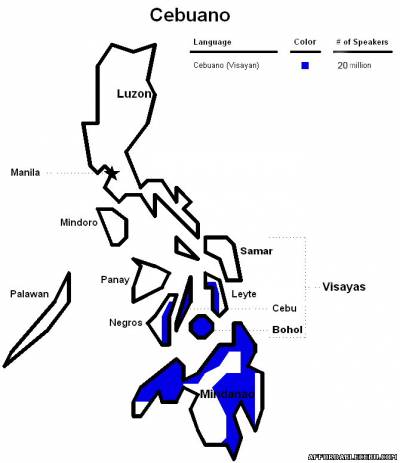All About Bisaya Language
Philippines is divided into three (3) island groups: Luzon, Visayas, Mindanao.
If you are living outside the Visayas and Mindanao Region, you might be confused of the definition of the term "Bisaya".
"Bisaya" term per se is not an official term of language or an official term of people pertaining to the term.
Most people living in Visayas and Mindanao used "Cebuano" as the official name of their language.
But where does Bisaya term come from or how did the term "Bisaya" change or evolve?
Bisaya language is too broad.
The "Bisaya" term is just widely known and heard. Most people in Visayas and Mindanao used this term too often. They use this term to pertain either to the language or to the people speaking the language.
A person living in Luzon may asked a person who is living in Visayas or Mindanao, "Bisaya ka ba?" ("Are you a Bisaya"?). The person being asked usually answers "oo" ("oo" means "yes" in English).
"Bisaya" term actually comes from the word or should we safely say evolves from the word "Visayas". If a person is living in Visayas, he/she is usually called by others as Bisaya. So, "Bisaya" term also pertains to a person.
"Bisaya" term doesn't only pertains to a person living in Visayas or Mindanao region. It is also very widely used as a language by the people living in Visayas or Mindanao region. If a person living in Luzon asks a person living in Visayas or Mindanao region, "Ano ba salita ginagamit mo?" ("What language are you using?"), that person living in Visayas or Mindanao region will usually answer "Bisaya".
You might ask what is the difference between "Bisaya" and "Cebuano" term.
"Bisaya" is broader than "Cebuano". "Bisaya" also pertains to people who are not speaking "Cebuano" such as the people living in Leyte who are "Waray People", people who are living in Surigao ( they used Surigaonon language ) but they are also widely called Bisaya people.
So don't be confuse anymore about the term "Bisaya". I am a Bisaya. This is based on my common sense and practical experiences. I traveled many places in Philippines with many languages. I used to lived in Metro Manila, Luzon 4 years when I was in College. My hometown is in Mindanao. I'm now recently living in Cebu. Don't hesitate to ask some questions or comments.
Do you know that?
"Cebuano has the largest speaking population of the Philippines despite not being taught formally in schools and universities. Cebuano is given the ISO 639-2 three letter code ceb, but has no ISO 639-1 two-letter code. Cebuano is an Austronesian language spoken in the Philippines by about 20 million people. It is the most widely spoken member of the Visayan languages; a language closely related to Malaysian, Indonesian, and other Filipino languages." - wikipedia
- https://www.affordablecebu.com/
"Bisaya" term actually comes from the word or should we safely say evolves from the word "Visayas". If a person is living in Visayas, he/she is usually called by others as Bisaya. So, "Bisaya" term also pertains to a person.
"Bisaya" term doesn't only pertains to a person living in Visayas or Mindanao region. It is also very widely used as a language by the people living in Visayas or Mindanao region. If a person living in Luzon asks a person living in Visayas or Mindanao region, "Ano ba salita ginagamit mo?" ("What language are you using?"), that person living in Visayas or Mindanao region will usually answer "Bisaya".
You might ask what is the difference between "Bisaya" and "Cebuano" term.
"Bisaya" is broader than "Cebuano". "Bisaya" also pertains to people who are not speaking "Cebuano" such as the people living in Leyte who are "Waray People", people who are living in Surigao ( they used Surigaonon language ) but they are also widely called Bisaya people.
So don't be confuse anymore about the term "Bisaya". I am a Bisaya. This is based on my common sense and practical experiences. I traveled many places in Philippines with many languages. I used to lived in Metro Manila, Luzon 4 years when I was in College. My hometown is in Mindanao. I'm now recently living in Cebu. Don't hesitate to ask some questions or comments.
TRIVIA
Do you know that?
"Cebuano has the largest speaking population of the Philippines despite not being taught formally in schools and universities. Cebuano is given the ISO 639-2 three letter code ceb, but has no ISO 639-1 two-letter code. Cebuano is an Austronesian language spoken in the Philippines by about 20 million people. It is the most widely spoken member of the Visayan languages; a language closely related to Malaysian, Indonesian, and other Filipino languages." - wikipedia
